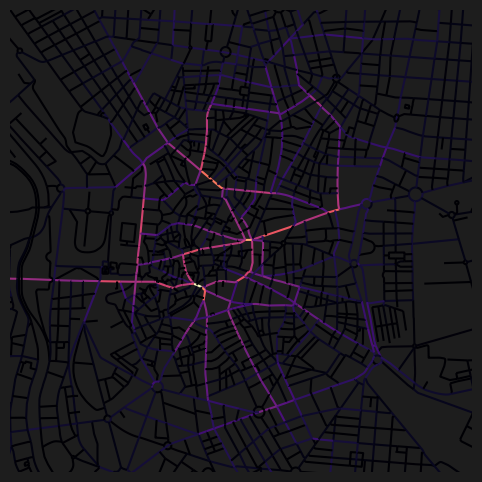import geopandas as gpd
import matplotlib.pyplot as plt
from cityseer.metrics import networks
from cityseer.tools import graphs, ioAngular distance network centrality
Calculate angular (geometric or “simplest”) distance centralities from a geopandas GeoDataFrame.
Prepare the network as shown in other examples. Working with the dual graph is recommended.
streets_gpd = gpd.read_file("data/madrid_streets/street_network.gpkg")
streets_gpd = streets_gpd.explode(reset_index=True)
G = io.nx_from_generic_geopandas(streets_gpd)
G_dual = graphs.nx_to_dual(G)INFO:cityseer.tools.graphs:Merging parallel edges within buffer of 1.
INFO:cityseer.tools.graphs:Converting graph to dual.
INFO:cityseer.tools.graphs:Preparing dual nodes
INFO:cityseer.tools.graphs:Preparing dual edges (splitting and welding geoms)Use network_structure_from_nx from the cityseer package’s io module to prepare the GeoDataFrames and NetworkStructure.
# prepare the data structures
nodes_gdf, _edges_gdf, network_structure = io.network_structure_from_nx(
G_dual,
)INFO:cityseer.tools.io:Preparing node and edge arrays from networkX graph.
INFO:cityseer.graph:Edge R-tree built successfully with 104026 items.Use the node_centrality_simplest function from the cityseer package’s networks module to calculate shortest angular (geometric or “simplest”) distance centralities. The function requires a NetworkStructure and nodes GeoDataFrame prepared with the network_structure_from_nx function in the previous step.
The function can calculate centralities for numerous distances at once via the distances parameter, which accepts a list of distances.
The function returns the nodes GeoDataFrame with the outputs of the centralities added as columns. The columns are named cc_{centrality}_{distance}_ang. Standard geopandas functionality can be used to explore, visualise, or save the results. See the documentation for more information on the available centrality formulations.
distances = [500, 2000]
nodes_gdf = networks.node_centrality_simplest(
network_structure=network_structure,
nodes_gdf=nodes_gdf,
distances=distances,
)
nodes_gdf.head()INFO:cityseer.metrics.networks:Computing simplest path node centrality.
INFO:cityseer.config:Metrics computed for:
INFO:cityseer.config:Distance: 500m, Beta: 0.008, Walking Time: 6.25 minutes.
INFO:cityseer.config:Distance: 2000m, Beta: 0.002, Walking Time: 25.0 minutes.| ns_node_idx | x | y | live | weight | primal_edge | primal_edge_node_a | primal_edge_node_b | primal_edge_idx | dual_node | cc_density_500_ang | cc_density_2000_ang | cc_harmonic_500_ang | cc_harmonic_2000_ang | cc_hillier_500_ang | cc_hillier_2000_ang | cc_farness_500_ang | cc_farness_2000_ang | cc_betweenness_500_ang | cc_betweenness_2000_ang | |
|---|---|---|---|---|---|---|---|---|---|---|---|---|---|---|---|---|---|---|---|---|
| x454839.5-y4476885.3_x454855.9-y4476818.6_k0 | 0 | 454848.067543 | 4.476852e+06 | True | 1 | LINESTRING (454855.9 4476818.6, 454849.1 44768... | x454855.9-y4476818.6 | x454839.5-y4476885.3 | 0 | POINT (454848.067543 4476852.042507) | 30.0 | 124.0 | 12.848804 | 26.465605 | 10.168567 | 18.186932 | 88.508049 | 845.442261 | 0.0 | 0.0 |
| x454833.6-y4476910.5_x454839.5-y4476885.3_k0 | 1 | 454836.577015 | 4.476898e+06 | True | 1 | LINESTRING (454839.5 4476885.3, 454838 4476891... | x454839.5-y4476885.3 | x454833.6-y4476910.5 | 0 | POINT (454836.577015 4476897.9067) | 36.0 | 127.0 | 14.853752 | 28.316143 | 10.232138 | 18.836437 | 126.659744 | 856.265991 | 136.0 | 968.0 |
| x454839.5-y4476885.3_x454877.1-y4476893.6_k0 | 2 | 454858.300000 | 4.476889e+06 | True | 1 | LINESTRING (454839.5 4476885.3, 454877.1 44768... | x454839.5-y4476885.3 | x454877.1-y4476893.6 | 0 | POINT (454858.3 4476889.45) | 33.0 | 125.0 | 12.366441 | 24.028734 | 9.009537 | 16.524494 | 120.871918 | 945.566040 | 106.0 | 752.0 |
| x454823.1-y4476952.1_x454833.6-y4476910.5_k0 | 3 | 454828.362585 | 4.476931e+06 | True | 1 | LINESTRING (454833.6 4476910.5, 454830.4 44769... | x454833.6-y4476910.5 | x454823.1-y4476952.1 | 0 | POINT (454828.362585 4476931.303206) | 36.0 | 124.0 | 15.039588 | 28.382860 | 10.302912 | 18.803555 | 125.789688 | 817.717712 | 165.0 | 1180.0 |
| x454758.1-y4476894.6_x454833.6-y4476910.5_k0 | 4 | 454795.845199 | 4.476903e+06 | True | 1 | LINESTRING (454758.1 4476894.6, 454769.8 44768... | x454833.6-y4476910.5 | x454758.1-y4476894.6 | 0 | POINT (454795.845199 4476902.571916) | 33.0 | 125.0 | 9.605127 | 21.297651 | 8.002337 | 16.290869 | 136.085236 | 959.126282 | 0.0 | 0.0 |
nodes_gdf.columnsIndex(['ns_node_idx', 'x', 'y', 'live', 'weight', 'primal_edge',
'primal_edge_node_a', 'primal_edge_node_b', 'primal_edge_idx',
'dual_node', 'cc_density_500_ang', 'cc_density_2000_ang',
'cc_harmonic_500_ang', 'cc_harmonic_2000_ang', 'cc_hillier_500_ang',
'cc_hillier_2000_ang', 'cc_farness_500_ang', 'cc_farness_2000_ang',
'cc_betweenness_500_ang', 'cc_betweenness_2000_ang'],
dtype='object')nodes_gdf["cc_betweenness_2000_ang"].describe()count 47129.000000
mean 8083.850098
std 15415.607422
min 0.000000
25% 374.000000
50% 2210.000000
75% 8528.000000
max 227236.000000
Name: cc_betweenness_2000_ang, dtype: float64fig, ax = plt.subplots(1, 1, figsize=(8, 6), facecolor="#1d1d1d")
nodes_gdf.plot(
column="cc_harmonic_500_ang",
cmap="magma",
legend=False,
ax=ax,
)
ax.set_xlim(438500, 438500 + 3500)
ax.set_ylim(4472500, 4472500 + 3500)
ax.axis(False)(np.float64(438500.0),
np.float64(442000.0),
np.float64(4472500.0),
np.float64(4476000.0))
fig, ax = plt.subplots(1, 1, figsize=(8, 6), facecolor="#1d1d1d")
nodes_gdf.plot(
column="cc_betweenness_2000_ang",
cmap="magma",
legend=False,
ax=ax,
)
ax.set_xlim(438500, 438500 + 3500)
ax.set_ylim(4472500, 4472500 + 3500)
ax.axis(False)(np.float64(438500.0),
np.float64(442000.0),
np.float64(4472500.0),
np.float64(4476000.0))
Alternatively, you can define the distance thresholds using a list of minutes instead.
nodes_gdf = networks.node_centrality_simplest(
network_structure=network_structure,
nodes_gdf=nodes_gdf,
minutes=[15],
)INFO:cityseer.metrics.networks:Computing simplest path node centrality.
INFO:cityseer.config:Metrics computed for:
INFO:cityseer.config:Distance: 1200m, Beta: 0.00333, Walking Time: 15.0 minutes.The function will map the minutes values into the equivalent distances, which are reported in the logged output.
nodes_gdf.columnsIndex(['ns_node_idx', 'x', 'y', 'live', 'weight', 'primal_edge',
'primal_edge_node_a', 'primal_edge_node_b', 'primal_edge_idx',
'dual_node', 'cc_density_500_ang', 'cc_density_2000_ang',
'cc_harmonic_500_ang', 'cc_harmonic_2000_ang', 'cc_hillier_500_ang',
'cc_hillier_2000_ang', 'cc_farness_500_ang', 'cc_farness_2000_ang',
'cc_betweenness_500_ang', 'cc_betweenness_2000_ang',
'cc_density_1200_ang', 'cc_harmonic_1200_ang', 'cc_hillier_1200_ang',
'cc_farness_1200_ang', 'cc_betweenness_1200_ang'],
dtype='object')As per the function logging outputs, 15 minutes has been mapped to 1200m at default speed_m_s, so the corresponding outputs can be visualised using the 1200m columns. Use the configurable speed_m_s parameter to set a custom metres per second walking speed.
fig, ax = plt.subplots(1, 1, figsize=(8, 6), facecolor="#1d1d1d")
nodes_gdf.plot(
column="cc_harmonic_1200_ang",
cmap="magma",
legend=False,
ax=ax,
)
ax.set_xlim(438500, 438500 + 3500)
ax.set_ylim(4472500, 4472500 + 3500)
ax.axis(False)(np.float64(438500.0),
np.float64(442000.0),
np.float64(4472500.0),
np.float64(4476000.0))
